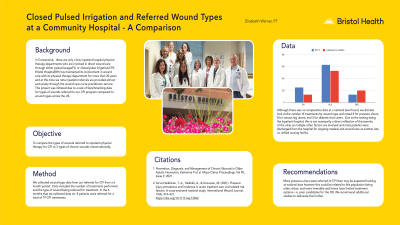Evidence-Based Practice
(EBP-021) Closed Pulsed Irrigation and Referred Wound Types at a Community Hospital- a Comparison
Friday, May 2, 2025
7:45 PM - 8:45 PM East Coast USA Time

Introduction: In Connecticut, there are only a few inpatient hospital physical therapy departments who are involved in direct wound care through either pulsed lavage(PL) or closed pulse irrigation(CPI). Bristol Hospital(BH) has maintained its involvement in wound care with its physical therapy department for more than 30 years and at this time we note inpatient referrals are provided almost exclusively through the wound care nurse practitioner service. This project was initiated due to a lack benchmarking data for types of wounds referred to our CPI program compared to wound types across the US.
Methods: We collected wound type data from referrals to CPI from a 6 month period. Data included the number of treatments performed and the type of wound being referred for treatment. In the 6 months that we collected data, 8 patients were referred for a total of 19 treatments.
Results: Data reveals the majority of the wound types referred were venous leg ulcers at 63% which is inline with national data showing 45-60% of all chronic wounds are venous leg ulcers.1 The 2nd most commonly treated by BH CPI were pressure ulcers at 25% with national data showing up to 12.7% of hospitalized patients with pressure ulcers.2 The 3rd most common treated were diabetic foot ulcers at 13% with national data showing 15-25%.1 Although there was no comparative data at a national level found, we did also look at the number of treatments by wound type and noted 8 for pressure ulcers, 8 for venous leg ulcers, and 3 for diabetic foot ulcers. Due to the setting being the inpatient hospital, this is not necessarily a direct reflection of the severity of the ulcer as multiple other factors are involved and most patients were discharged from the hospital for ongoing medical and wound care at another site, i.e. skilled nursing facility.
Discussion: Upon looking at the data, it was noted that more pressure ulcers were referred to CPI then may be expected compared to national data however this could be related to this population being older, sicker, and more immobile and hence have limited treatment options- i.e. poor candidates for the OR. We recommend additional studies with larger sample sizes in hospitals across multiple locations. Additionally, studies looking specifically at the patient’s discharge location and wound care plan post-hospital discharge may also be beneficial to further understand this population.
Methods: We collected wound type data from referrals to CPI from a 6 month period. Data included the number of treatments performed and the type of wound being referred for treatment. In the 6 months that we collected data, 8 patients were referred for a total of 19 treatments.
Results: Data reveals the majority of the wound types referred were venous leg ulcers at 63% which is inline with national data showing 45-60% of all chronic wounds are venous leg ulcers.1 The 2nd most commonly treated by BH CPI were pressure ulcers at 25% with national data showing up to 12.7% of hospitalized patients with pressure ulcers.2 The 3rd most common treated were diabetic foot ulcers at 13% with national data showing 15-25%.1 Although there was no comparative data at a national level found, we did also look at the number of treatments by wound type and noted 8 for pressure ulcers, 8 for venous leg ulcers, and 3 for diabetic foot ulcers. Due to the setting being the inpatient hospital, this is not necessarily a direct reflection of the severity of the ulcer as multiple other factors are involved and most patients were discharged from the hospital for ongoing medical and wound care at another site, i.e. skilled nursing facility.
Discussion: Upon looking at the data, it was noted that more pressure ulcers were referred to CPI then may be expected compared to national data however this could be related to this population being older, sicker, and more immobile and hence have limited treatment options- i.e. poor candidates for the OR. We recommend additional studies with larger sample sizes in hospitals across multiple locations. Additionally, studies looking specifically at the patient’s discharge location and wound care plan post-hospital discharge may also be beneficial to further understand this population.

.jpg)